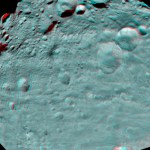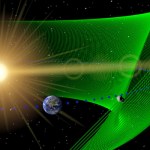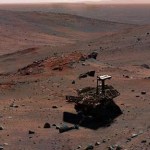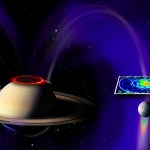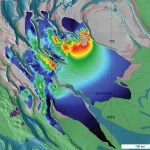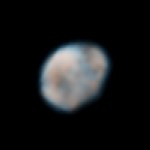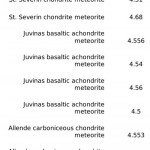Cosmos
3D Image of Vesta's Equatorial Region
This anaglyph image of Vesta's equator was put together from two clear filter images, taken on July 24, 2011 by the framing camera instrument aboard NASA's Dawn spacecraft. The anaglyph image shows hills, troughs, ridges and steep craters. The framing camera has a resolution of about 524 yards (480 meters) per pixel. Use red-green (or red-blue) glasses to view in 3-D (left eye: red; right eye: green [or blue]).
The Dawn mission to Vesta and Ceres is managed by the Jet Propulsion Laboratory, for NASA's Science Mission Directorate, Washington, D.C. It is…
Observations from NASA's Mars Reconnaissance Orbiter have revealed possible flowing water during the warmest months on Mars.
"NASA's Mars Exploration Program keeps bringing us closer to determining whether the Red Planet could harbor life in some form," NASA Administrator Charles Bolden said, "and it reaffirms Mars as an important future destination for human exploration."
Dark, finger-like features appear and extend down some Martian slopes during late spring through summer, fade in winter, and return during the next spring. Repeated observations have tracked the seasonal changes in these…
The Herschel Space Observatory's large telescope and state-of-the-art infrared detectors have provided the first confirmed finding of oxygen molecules in space. The molecules were discovered in the Orion star-forming complex.
Individual atoms of oxygen are common in space, particularly around massive stars. But molecular oxygen, which makes up about 20 percent of the air we breathe, has eluded astronomers until now.
"Oxygen gas was discovered in the 1770s, but it's taken us more than 230 years to finally say with certainty that this very simple molecule exists in space," said Paul Goldsmith…
PASADENA, Calif. - Astronomers studying observations taken by NASA's Wide-field Infrared Survey Explorer (WISE) mission have discovered the first known "Trojan" asteroid orbiting the sun along with Earth.
Trojans are asteroids that share an orbit with a planet near stable points in front of or behind the planet. Because they constantly lead or follow in the same orbit as the planet, they never can collide with it. In our solar system, Trojans also share orbits with Neptune, Mars and Jupiter. Two of Saturn's moons share orbits with Trojans.
Scientists had predicted Earth should have Trojans…
They won't let Pluto be a planet but it still bears the responsibility of having moons, and until just now there were three known moons of the tiny non-planet, named Hydra, Charon and Nix.
Now there are four, and the fourth one is called Essslashtwoohoneonepeeone.
They are working on another name. Bad Astronomer has details about the new find.
There is some difficulty in coming up with a name since the theme of the existing names (night-based Roman mythical character) is tapped out. I was thinking it should be called one of the following:
Fifi
Dinah
Ronnie
Or, to be funny, Milton…
NASA's Dawn space ship is getting closer to the asteroid Vesta, and has produced a very short movie. The movie is a compilation of 20 frames, shown here repeating several times:
This movie shows surface details beginning to resolve as NASA's Dawn spacecraft closes in on the giant asteroid Vesta. The framing camera aboard NASA's Dawn spacecraft obtained the images used for this animation on June 1, 2011, from a distance of about 300,000 miles (483,000 kilometers).
Vesta's jagged shape, sculpted by eons of cosmic impacts in the main asteroid belt, is apparent. Variations in surface brightness…
NASA is going to send two probes to the moon, later this summer. They are called "GRAIL" which stands for Gravity Recovery And Interior Laboratory. They will orbit the moon in an effort to determine the structure of its interior. They will be launched by a Delta II rocket some time between early September and mid October, depending on the usual factors.
The plan is to generate a highly accurate gravitatoial map of the moon.
The high-resolution gravitational field, especially when combined with a comparable-resolution topographical field, will enable scientists to deduce the Moon's…
The last communication from the Mars Rover Spirit was on March 22, 2010. A few moments ago NASA announced that there would be no more attempts to contact the space robot after a transmission that will end on May 25th.
It is suspected that Spirit's internal circuitry was damaged by very low temperatures experienced during the Martian winter. While it was hoped that solar panels would allow heaters to bring the robot back to life, this apparently has not happened. The resources that would be needed to continue what seems to be a fruitless attempt at communication are now needed elsewhere…
PASADENA, Calif. -- NASA is releasing the first images and sounds of an electrical connection between Saturn and one of its moons, Enceladus. The data collected by the agency's Cassini spacecraft enable scientists to improve their understanding of the complex web of interaction between the planet and its numerous moons. The results of the data analysis are published in the journals Nature
Scientists previously theorized an electrical circuit should exist at Saturn. After analyzing data that Cassini collected in 2008, scientists saw a glowing patch of ultraviolet light emissions near Saturn's…
A newly found, buried deposit of frozen carbon dioxide -- dry ice -- near the south pole of Mars contains about 30 times more carbon dioxide than previously estimated to be frozen near the pole. This map color-codes thickness estimates of the deposit derived and extrapolated from observations by the Shallow Subsurface Radar (SHARAD) instrument on NASA's Mars Reconnaissance Orbiter. The orbiter does not pass directly over the pole, and the thickness estimates for that area (with smoother transitions from color to color) are extrapolations.
Red corresponds to about 600 meters or yards thick;…
The abstract for a recent paper on Titan says:
...We propose a new Cassini state model for Titan in which we assume the presence of a liquid water ocean beneath an ice shell and consider the gravitational and pressure torques arising between the different layers of the satellite....
Titan's orbit, recently measured to a high degree of accuracy, looks more like an object with an ocean sloshing around than like a solid object. The story is expanded on in this blog post.
Europa is a moon of Jupiter, the smallest of the four Jovian moons discovered by Galileo in 1610. Juipter has 63 objects circling it that are called moons, though only eight of them are "regular" in their orbit and other characteristics. The rest are bits and pieces of clumped up matter that were probably captured by Jupiter's big-ass gravitational field, and have irregular orbits, i.e., they go the wrong-way around the planet, or are not in the solar plane, etc.
Europa is almost as big as the Earth's moon, probably has an iron core, and is otherwise made of silica. There is an atmosphere…
Did you year the interview with Neil deGrasse Tyson today?
If not, that's OK, it's a podcast.
But first, a hint for those of you who want to do interviews. There's a trick to make it go well. Interview someone like Dr. Tyson, with his knowledge, enthusiasm, and experience in public media; Ask him a couple/few questions; Sit back and listen to all the good words that come out. Break occasionally for commercials if needed.
I did actually have a strategy, which was fairly simple: I wanted to avoid the most obvious topics that have been covered so often in interviews with a person who must…
Information gleaned form Cassini, Galileo and New Horizons missions seems to indicate that ripples seen in the rings of Saturn and Jupiter were caused by comets. Shoemaker-Levy 9 (famous for a multiplicity of impacts on Jupiter in 1994) left one set of ripples. Saturn's cometary clues date to a cloud of icy debris passing through the inner rings in 1983.
"What's cool is we're finding evidence that a planet's rings can be affected by specific, traceable events that happened in the last 30 years, rather than a hundred million years ago," said Matthew Hedman, a Cassini imaging team…
Yes, yes, I know ... Death by Black Hole: And Other Cosmic Quandaries by Neil deGrasse Tyson did not just come out, and it is not part of any current news story, so I'm not supposed to mention it in a blog post, because blog posts are only about things that happened during the last forty-five minutes or so. But what did happen in the last few minutes is that I finished reading it, and I'm recommending it to you.
It is said that Neil deGrasse Tyson is a modern day Carl Sagan ... an astronomer who is superb at communicating science to the masses. That is sort of true but not exactly. Sagan…
This is the picture of Vesta, which is an object in our solar system:
That's the picture that Wikipedia uses as of this writing, and it was taken by the Hubble. The key thing to note is that Vesta, which lies in the asteroid belt and has been thought of as a big asteroid, is very globular like a planet. This is unusual for an asteroid.
This is a picture of Vesta as conceptualized by NASA scientists. It is a model, not a photograph.
Model of Vesta This image shows a model of the protoplanet Vesta, using scientists' best guess to date of what the surface of the protoplanet might look…
This just in from NASA:
PASADENA, Calif. -- NASA's Stardust spacecraft sent its last transmission to Earth at 4:33 .m. PDT (7:33 p.m. EDT) Thursday, March 24, shortly after depleting fuel and ceasing operations. During a 12-year period, the venerable spacecraft collected and returned comet material to Earth and was reused after the end of its prime mission in 2006 to observe and study another comet during
February 2011.
The Stardust team performed the burn to depletion because the comet hunter was literally running on fumes. The depletion maneuver command was sent from the Stardust-NExT…
For the first time, rain has been observed falling at low altitude on this moon of Saturn.
Extensive rain from large cloud systems, spotted by Cassini's cameras in late 2010, has apparently darkened the surface of the moon. The best explanation is these areas remained wet after methane rainstorms. The observations released today in the journal Science, combined with earlier results in Geophysical Research Letters last month, show the weather systems of Titan's thick atmosphere and the changes wrought on its surface are affected by the changing seasons.
"It's amazing to be watching such…
Remembering Dr. Emma Bakes
An exceptional person, Dr. Emma Bakes passed away on February 28, 2011. She accomplished a great deal and touched many people in an unfortunately short time. Her accomplishments span oceans and included the physical sciences, medicine, fashion, martial arts, and parenthood to name just a few. To honor and remember her, the SETI Institute and NASA's Kepler Mission Team invite you to read the following essay she wrote just a few months ago. It is an essay that reflects her life and her legacy...
Donald Mendoza, NASA Ames, and the SETI Institute
The Shore of the Cosmic…
How old is the earth?
Short answer: 4,540,000,00/H30 Earth-years, plus or minus 1%.
Long answer: We don't know exactly because direct dating of the earliest material on the surface of the Earth will only tell use a minimum age; Prior to that, the Earth's surface was probably molten, and even after that, it may be that the earliest non-molten material has been recycled into the planet's interior by tectonic processes. Also, the earth is a big round ball of stuff that condensed into this shape from part of a large disk-shaped blob of stuff known as the Solar Nebula. When exactly, given this,…
